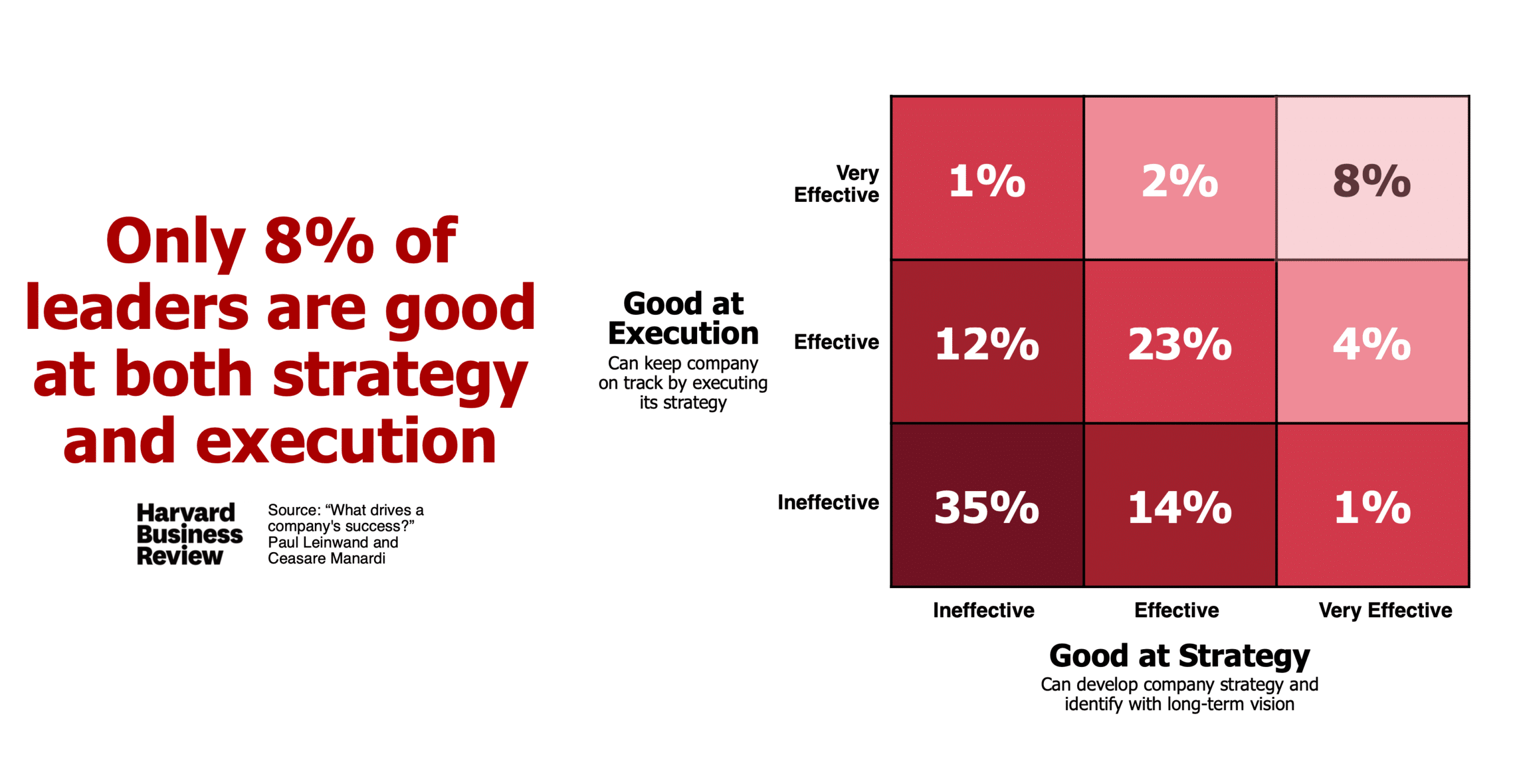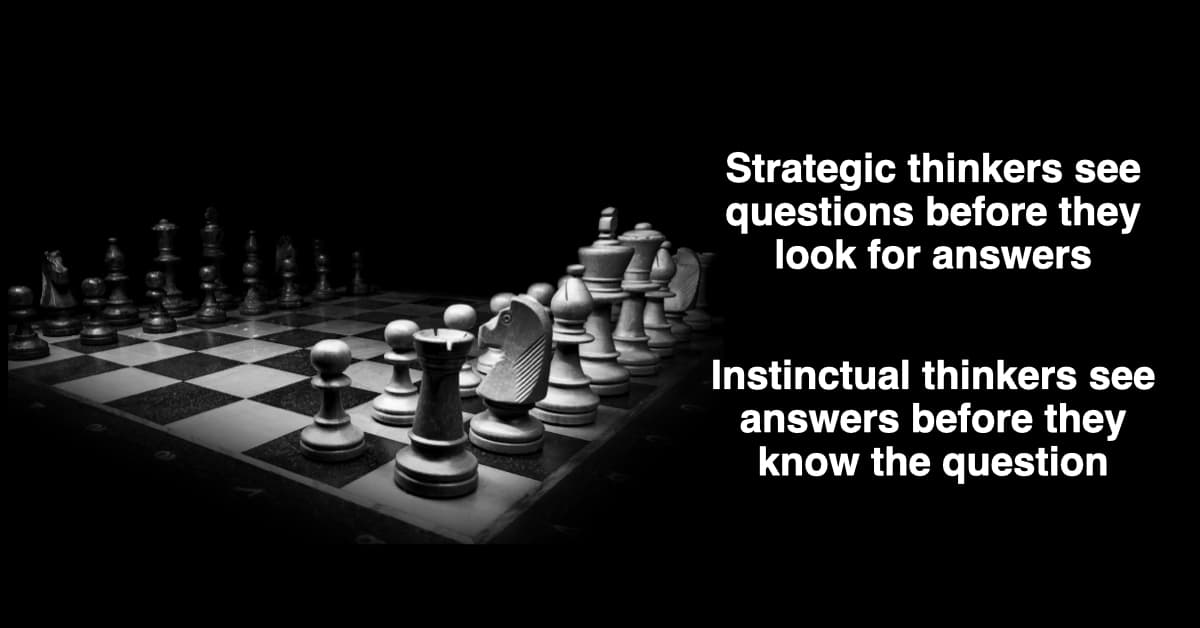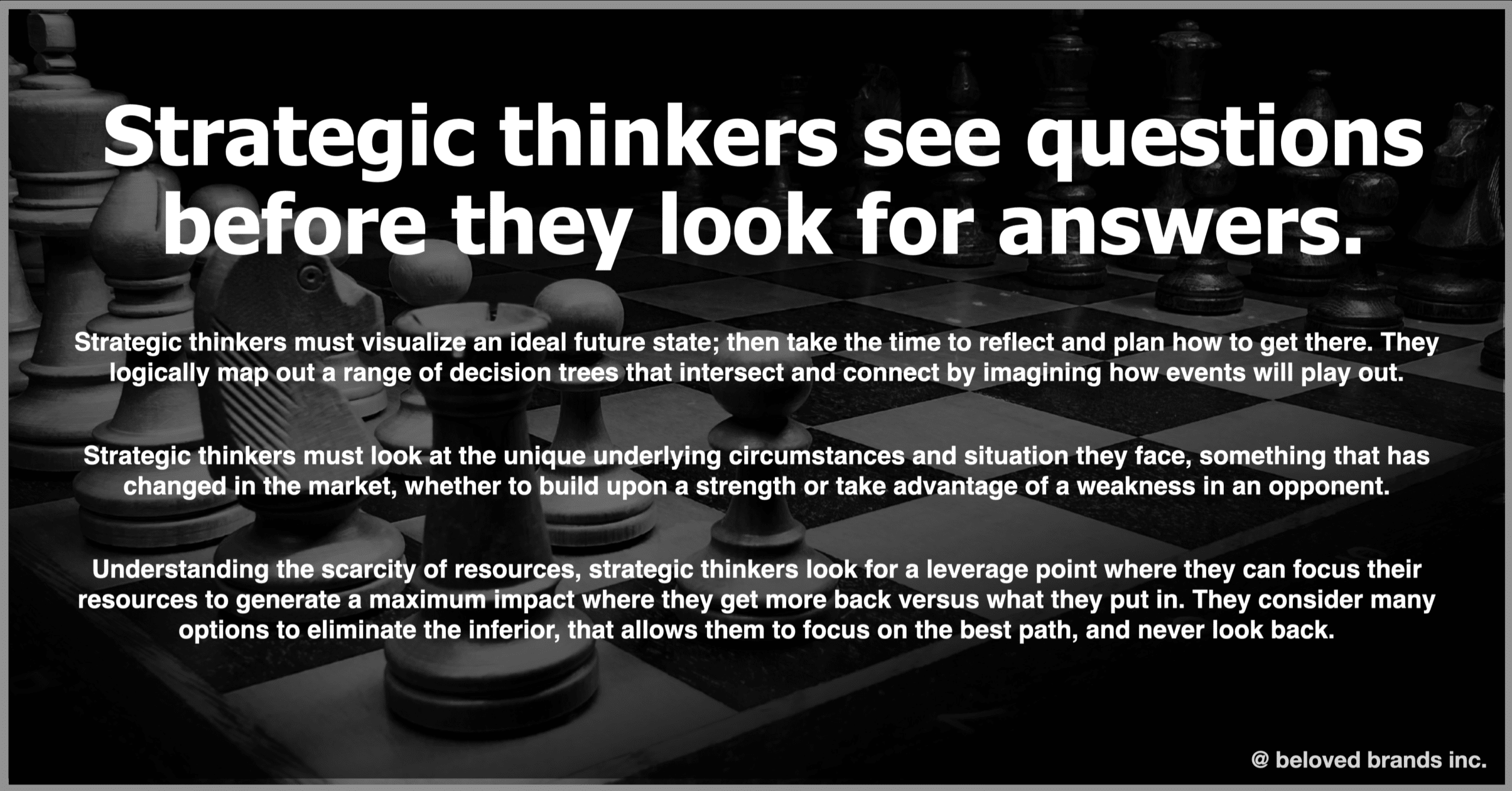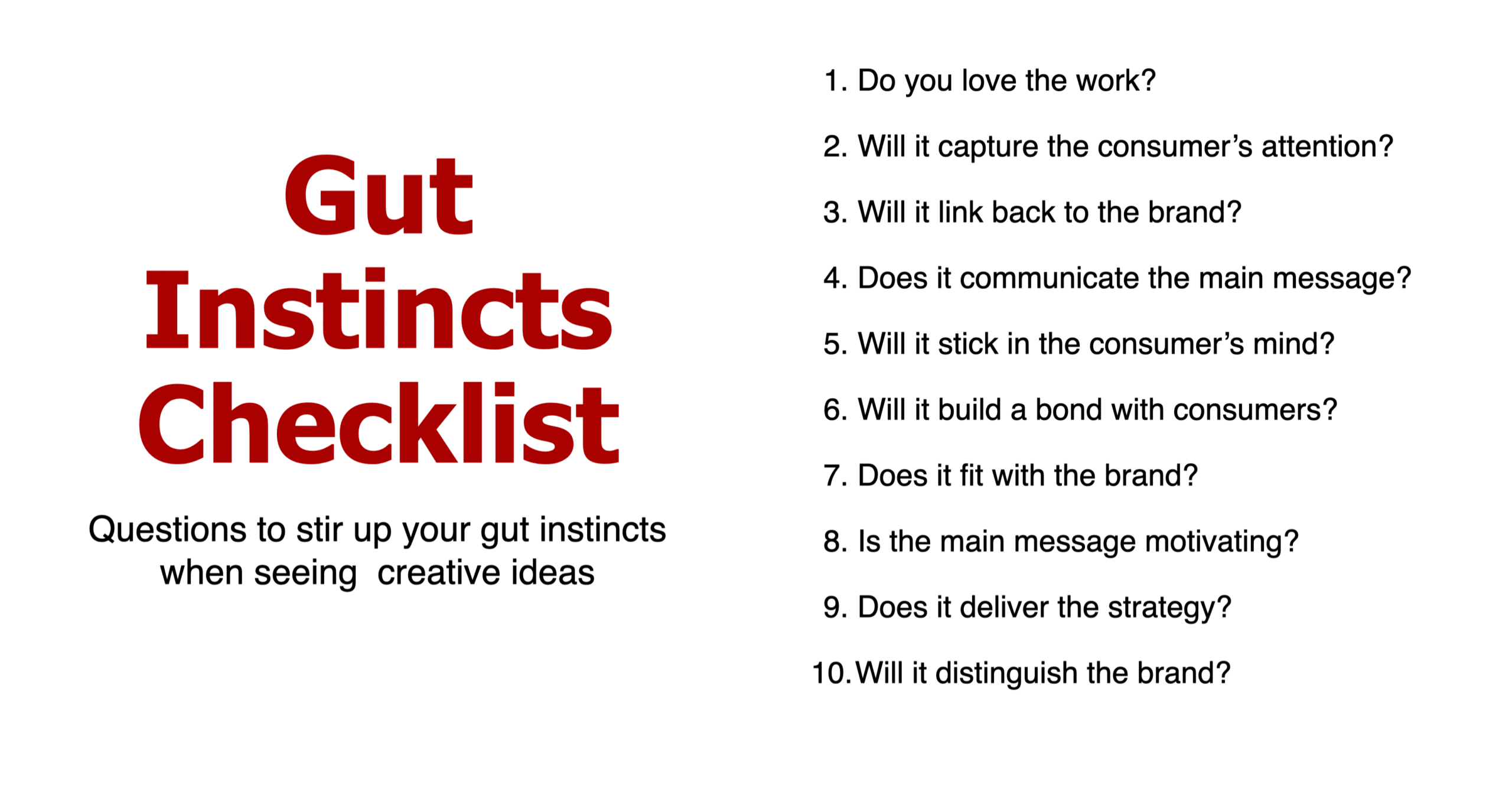In marketing, leadership is not just about knowing what to do but how to approach every unique situation. Situational leadership for marketers is guided by two key dynamics: how you think and how you decide. This interplay determines your ability to adapt and thrive in a fast-paced, ever-evolving business landscape.
Are you predominantly a Strategic Thinker, Instinctual Thinker, Consensus Socializer, or Taskmaster? More importantly, which is your blind spot?
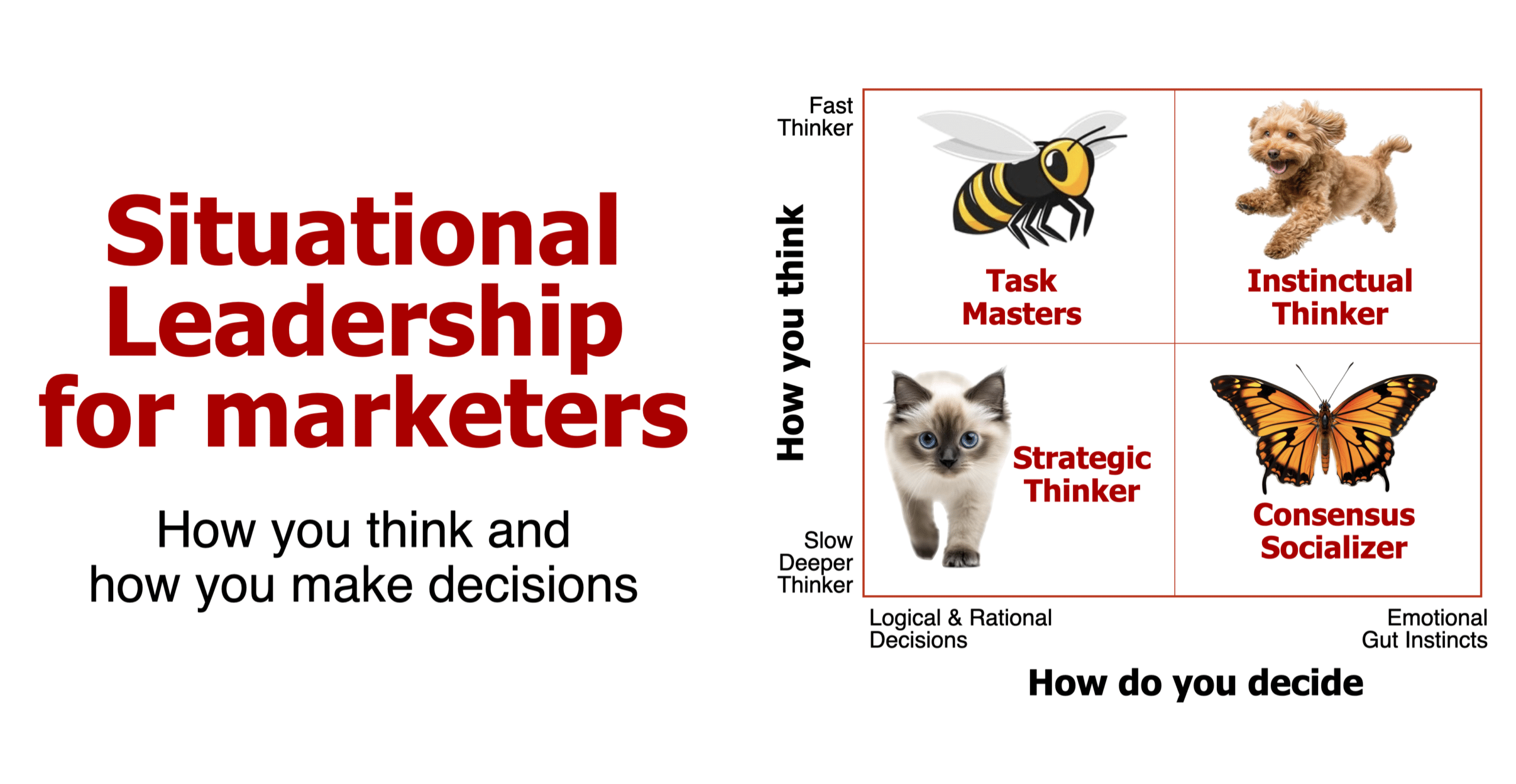
The Leadership Spectrum: How you think and how you decide
As a marketer, you might identify as a quick, intuitive thinker or someone who prefers slower, deeper thinking. Similarly, your decisions might lean on logic and rationale or on emotional gut instincts. These dimensions create a spectrum of leadership styles that can be leveraged at the right time.
1️⃣ Strategic Thinker:
Slow Thinker + Rational Logic: The Strategic Thinker carefully analyzes the situation, focusing on long-term outcomes and resource efficiency.
2️⃣ Instinctual Thinker:
Fast Thinker + Emotional Instincts: The Instinctual Thinker thrives in fast-paced environments, using gut instincts to make quick decisions.
3️⃣ Consensus Socializer:
Slow Thinker + Emotional Instincts: The Consensus Socializer ensures buy-in from stakeholders, valuing emotional connections in decision-making.
4️⃣ Taskmaster:
Fast Thinker + Rational Logic: The Task Master excels in execution, moving swiftly while staying grounded in logic.
The best marketers have flexible brains
When I was running a marketing team at J&J, I said, “the best marketers know what they want and then make it happen.” The worst marketers know what they want but can’t make it happen, or they can make it happen but rely on someone else to develop their strategy. Now, we have some statistical proof that this is true.
The chart above aligns perfectly with the principles of situational leadership for marketers and highlights why the ability to excel in both strategy and execution is vital in today’s marketing landscape. As the chart reveals, only 8% of leaders are effective at both, showcasing how rare it is to find individuals who can balance these two critical dimensions. For marketers, this balance isn’t optional—it’s essential.
The Challenge for Marketers
In marketing, strategy, and execution go hand-in-hand. Strategy defines the long-term vision: where your brand is headed, the opportunities you’ll pursue, and the leverage points to create maximum impact. Execution ensures those strategies are brought to life effectively with campaigns, activations, and decisions that resonate with consumers and drive results. Falling short in either area can lead to significant consequences.
- Strong Strategy, Poor Execution: You may craft a compelling vision, but it fails to translate into tangible results, leaving the brand stagnant.
- Strong Execution, Poor Strategy: You can move quickly and produce activity, but it may lack focus or solve the wrong problems.
The Situational Leadership Lens
Marketers, by the very nature of their roles, must adapt their leadership styles to the situation at hand. Some scenarios demand a Strategic Thinker, carefully mapping out decision trees and planning for long-term impact. Other situations call for a Taskmaster, executing with speed and precision to capitalize on immediate opportunities.
However, the best marketers know they can’t rely solely on their natural strengths. They must:
- Shift Their Thinking Speed: Move between fast, intuitive decisions and slow, deliberate analysis.
- Balance Emotions and Logic: Ensure emotional resonance in strategies while grounding decisions in rational, data-backed insights.
- Excel in Both Dimensions: Understand the interplay between crafting a vision and executing it flawlessly.
Why Being Both Matters
Brands don’t thrive on strategy alone, nor do they succeed through execution without direction. Effective marketers are those who:
- Understand when to zoom out and see the big picture.
- Know when to dive into the details to ensure flawless delivery.
- Can influence stakeholders to align with their vision and guide their teams to execute with excellence.
Marketers who embrace situational leadership and master both strategy and execution can elevate their brands, staying ahead in competitive markets. As the chart reminds us, these dual capabilities are rare—but they are the hallmark of truly great marketing leaders. Ask yourself: where do you stand, and how can you adapt to be both?
Mastering Situational Leadership in Marketing
The Essence of Situational Leadership Style in Marketing
In my early marketing days, I predominantly leaned on my instincts. But as I climbed the corporate ladder, the importance of strategic thinking became glaringly evident. Every marketer has a natural style, an asset that gives them an edge. But there’s also often a gap, a style that doesn’t come as naturally. Recognizing and bridging this gap is essential, especially when facing challenges or aiming for senior roles.
Visualize your marketing approach like a race car driver’s strategy. Knowing when to accelerate and when to ease the gas is vital.
Drawing from my book, “Beloved Brands,” the ThinkBox concept is akin to an athlete sizing up a shot and contemplating the challenges before executing. Similarly, in marketing, strategic thinking must precede instinctual execution. Once the strategy is set, shifting to an instinctual mode helps in creative execution, after which the consensus socializer style aids in selling the ideas, and eventually, the taskmaster ensures efficient rollout.
To illustrate, you can see when to use your slower strategic thinking vs. fast instinctual thinking style.
The dynamic landscape of marketing requires leaders to be fluid in their approach. At different junctures, different leadership styles take precedence:
- Strategic Thinkers: Drive deep dives to unearth insights and frame strategy.
- Instinctual Thinkers: Infuse creativity, ensuring the brand resonates emotionally with consumers.
- Consensus Socializers: Seamlessly weave different teams and stakeholders together, ensuring a unified approach.
- Taskmasters: Ensure the smooth translation of strategy into tangible results.
While having a dominant leadership style is advantageous, versatility is key. The art lies in recognizing when to lean into each style. Adapting your style based on the situation can be the difference between good and great marketing. Ensure you cultivate all four to excel truly.
Strategic Thinkers
Strategic Thinkers see questions before they look for answers
Ever hear someone say, “That’s a good question?” It usually means someone has just asked an interruptive question, designed to slow everyone’s thinking, so they reflect and plan before they act.
The strategic thinking side of marketing is logical and has to map out a range of decision trees that intersect, by imagining how events will play out in the future. Use logic to separate through the options, never getting too emotionally attached to an answer.
The trick to being strategic is to think slowly with strategy. If you move too quickly on brand strategy, you will be unable to see the insights beneath the surface, and you risk solving the wrong problem.
On the other hand, the risk of being only strategic is that, if you think too long, you may spiral around, unable to decide. Moreover, you may miss an opportunity window. Don’t be the smart guy who never gets anything done.
To illustrate, click to zoom in on this visual about the situational leadership style of strategic thinkers.
Five strategies to slow down so you can engage your thinking for enhanced strategic thinking:
1. Designate Time for Deep Thinking:
Instead of constantly glued to your desk or meetings, you can allocate specific moments for contemplation. These intervals can clarify whether it’s a midday stroll or a brief drive. Often, simple activities like gardening or working out can stimulate your mind differently, leading to fresh insights.
2. Structure Your Week for Thoughtful Engagement:
Start your week with concise updates on Monday, setting a clear cognitive stage for the upcoming days. Block out several “strategic reflection slots” throughout the week. These are moments reserved exclusively for deep consideration on specific topics. Such dedicated periods prevent daily chores from overshadowing necessary reflection.
3. Delve Deep Before Deciding:
It’s essential to immerse yourself in relevant data routinely. Regardless of your rank, being well-informed is crucial. Instead of just absorbing data, challenge every piece of information by turning it into a strategic question.
4. Cultivate the Skill of Posing Pertinent Questions:
While many marketers are in a rush to offer solutions, the power of posing the right questions can be transformative. Encouraging your team to reflect on these questions can usher in deeper understanding and better solutions.
5. Foster Cross-Functional Collaborations:
In terms of this situational leadership style, proactively engage with diverse teams. Address potential challenges proactively rather than during crises, where emotions can cloud judgment. Once you grasp their perspectives and apprehensions, devise well-thought-out and mutually beneficial solutions.
Instinctual Thinkers
Instinctual Thinkers inspire executional greatness
The best brands win because of the passionate and lasting love they have established with their most cherished consumers. It is the smart, creative marketing execution that consumers see and touch, whether it is an innovative product, engaging advertising, exceptional service, or the overall experience with the brand.
As the marketing leader, when you see new ideas coming from your team, you should first ask, “Do you love it?” as the first filter for what makes great work. Great brand leaders can never settle for O.K. Each time you reject O.K., the work naturally gets better. It will make your expectations higher. When you love your work, you will fight for it, with your agency, your boss, or anyone in the way.
On the other hand, if you do not love the work, how can you ever expect your consumers to love your brand? Your experts will see your passion shining through. The best instinctual leaders use their gut instincts to inspire creativity and judge which ideas will work. They move fast, using their impulsive and intuitive gut feel. They choose emotion over logic.
Five strategies to speed up your thinking and maximize your instincts in marketing
1. Trust your initial reactions:
When assessing marketing execution work, focus on its potential impact, alignment with the creative brief, and whether it’s something you’ll be proud of as part of your legacy. Avoid taking notes during creative meetings to concentrate on the big picture.
2. Embody the consumer:
Represent the consumer’s perspective to the brand. Understand their behavior, language, and reactions. Make sure your marketing execution leverages consumer insights to establish connections, strengthen bonds, and create memorable experiences.
3. Ensure brand consistency and differentiation:
Confirm that your marketing execution delivers the brand idea, utilizes creative assets, and reflects the brand’s tone. Identify functional or emotional benefits that resonate with consumers and are unique to the brand.
5. Uncover the magic in intelligent, creative marketing execution:
Aim to capture attention, engage consumers with the brand, and emphasize its significance. Communicate the primary benefit clearly and compellingly to inspire consumers to think, feel, or act.
5. Remain present and positive:
Foster a supportive team environment by maintaining a relaxed, upbeat attitude. Avoid unnecessary concerns that may stifle creativity, and focus on the idea’s potential.
By applying these strategies, you can effectively tap into your instincts and create impactful marketing executions.
To illustrate, click to zoom in on gut instincts situational leadership style.
Consensus Socializers
Consensus Socializers align everyone who works on the brand
While we don’t make the product, we don’t sell the product or create the ads, we do touch everything that goes into the marketplace and we make every decision. All of our work is done through other people.
Our greatness as a brand leader has to come from the experts we engage, so they will be inspired to reach for their own greatness and apply it to our brand. Brand management has been built on a hub-and-spoke system, with a team of experts surrounding the generalist brand leader.
Consensus socializers are able to move ideas and projects through an organization. These consensus socializers move slowly, use their emotional instincts, staying aware of what others think. You need a high EQ, to listen, maneuver and gain alignment across a complex organization. Regardless of strategy or execution, without alignment, you could run into roadblocks that halt any progress on the brand.
Five ways to excel with a consensus socializer leadership style
1. Use probing questions for deeper understanding:
With this leadership style, adopt a helicopter approach. Ask your experts to clarify the what, why, and how. Delve into the details until you have sufficient information, then move back to the surface level with a summary conclusion to facilitate decision-making.
2. Align with your experts’ motivations:
Understand and accommodate the objectives of your sales leaders, supply chain partners, and creative teams to avoid conflicts. Strive for mutual wins by aligning your brand’s growth with its goals.
3. Encourage everyone to deliver their best:
Elevate the significance of each expert’s contribution to the overall outcome of your brand, tapping into their personal pride as a powerful motivator. As the marketing leader, empower your team to achieve greatness.
4. Champion your ideas:
Recognize that the best solutions may not be obvious to everyone. Persuasively promote your ideas to gain support from colleagues and superiors, using facts where possible and conviction when necessary.
5. Take responsibility for decisions:
While experts can offer valuable advice, ultimately, you are the decision-maker. Embrace this responsibility and make informed choices based on the insights provided by your experts.
By implementing these strategies, you can effectively harness the consensus socializer leadership style to drive your brand’s success.
Taskmasters
Taskmasters use project management to make things happen
At the heart of being a successful task master is the realization there is a business to run. Without staying focused on the end goal, your strategic thinking and creative instincts can end up wasted, resulting in missed opportunities. Task masters stay in control to get things done, keep projects on time and on budget.
To stay in control, you must be organized and understand how each milestone impacts the other. You can never lose sight of the end goal, efficiently knocking down roadblocks, to keep everyone else on track with time and budgets.
When you overly rely on the task master style, you can destroy the deeper thinking and creativity in the name of hitting the deadline. You can end up with hollow thinking, with OK creativity and OK business results.
For every chosen marketing activity, your project plan should list the specifics around the project owner, support team, project budget, goals, milestones, and hurdles. When you have a team running your brand, these project plans are a very efficient way to manage your people and ensure the specific projects remain on track. This format sets up regular check-in meetings with your staff to keep every project moving towards completion.
Five ways to excel with a task master leadership style and make things happen
1. Set high standards for yourself and your team:
Demonstrate commitment to excellence by holding yourself and your team to consistently high standards in analytics, strategic thinking, planning, and execution across all aspects of your brand.
2. Be the process leader:
Organize, challenge, and manage processes to enable your team to focus on thinking, planning, and executing effectively. Use this leadership style to guide your team to complete tasks on time, within budget, and according to forecasts.
3. Lead your team with vision and engagement:
Provide a unifying vision to align your team and inspire each member in a personally meaningful way. Stay actively involved in supporting team members to accomplish their goals.
4. Meet every deadline:
Maintain control and organization by consistently meeting deadlines. In brand management, missed deadlines lead to lost opportunities rather than extensions.
5. Understand each team member’s leadership style:
Recognize the natural styles of each team member in group settings. Ensure your team is balanced, with individuals who excel at thinking, intuition, socializing ideas, and task management.
Adopting these strategies allows you to leverage the taskmaster situational leadership style effectively to drive success and make things happen for your brand.
As a marketing leader, use situational leadership to maneuver to the right leadership style for the right moment
Brand Management Mini MBA
Invest in your future. For the ambitious marketer looking to solidify their marketing skills. In that case, our Brand Management Mini MBA will teach you about strategic thinking, brand positioning, brand plans, advertising decisions, and marketing analytics.
Have a look at our brochure on our Mini MBA program
Use > to move through the brochure or x to see the full screen.
You get 36 training videos, key chapters from our Beloved Brands Playbook, and a Brand Management Workbook with exercises to try in real time. Earn a certificate you can use on your resume or LinkedIn profile.


